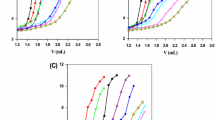Abstract
Adduct formation in the binary systems of O-phospho-L-serine with biogenic amines (putrescine, spermidine or spermine) has been investigated. The overall stability constants of the adducts and the equilibrium constants of their formation have been determined using computer analysis of potentiometric data. Ion-ion interactions have been established to occur in the identified molecular complexes. The potential reaction centers are phosphate, carboxylate and amine groups from phosphorylated serine as well as the –NH +3 and –NH +2 – groups from polyamine. The pH range of adduct formation is found to coincide with that in which the polyamine is protonated (positive reaction center) and the phosphoserine is partly or totally deprotonated (negative reaction center). The stability of the molecular complexes formed in the studied systems depends on the acid-base character of the substrates and on the structure of the reacting molecules. Sites of interactions in the bioligands have been deduced on the basis of the results of the equilibrium study and analysis of the changes in the positions of signals in the 13C and 31P NMR spectra.
Similar content being viewed by others
References
Sigel, H., Massoud, S.S.: Metal ion coordinating properties of pyrimidine-nucleoside 5′-monophosphates (CMP, UMP, TMP) and of simple phosphate monoesters, including D-ribose 5′-monophosphate. Establishment of relations between complex stability and phosphate basicity. Inorg. Chem. 27, 1447–1453 (1988). doi:10.1021/ic00281a030
Casassas, E., Izquierdo-Ridorsa, A., Tauler, R.: Study of the acid-base behaviour and Cu(II) complexing properties of uracil and hypoxanthin-derived nucleotides in aqueous solution. J. Inorg. Biochem. 56, 187–199 (1994). doi:10.1016/0162-0134(94)85005-4
Thomas, T., Thomas, T.J.: Polyamines in cell growth and cell death. Cell. Mol. Life Sci. 58, 244–258 (2001). Medline doi:10.1007/PL00000852
Srinath, P., McQuarrie, S.A., Suresh, M.R.: Comparative uptake of polyamines by prostate and non-prostate cancer cell lines. Nucl. Med. Biol. 29, 497–503 (2002). Medline doi:10.1016/S0969-8051(02)00287-1
Keniry, M.A.: A comparison of the association of spermine with duplex and quadruplex DNA by NMR. FEBS Lett. 542, 153–158 (2003). Medline doi:10.1016/S0014-5793(03)00373-9
D’Agostino, L., Luccia, A.: Polyamines interact with DNA as molecular aggregates. Eur. J. Biochem. 269, 4317–4325 (2002). Medline doi:10.1046/j.1432-1033.2002.03128.x
Pegg, A.E.: Polyamine metabolism and its importance in neoplastic growth and as a target for chemotherapy. Cancer Res. 48, 759–774 (1988)
Jänne, J., Alhonen, L., Leinonen, P.: Polyamines: from molecular biology to clinical applications. Ann. Med. 23, 241–259 (1991). Medline doi:10.3109/07853899109148056
Fiskin, M., Beer, M.: Determination of base sequence in nucleic acids with the electron microscope. IV. Nucleoside complexes with certain metal ions. Biochem. 4, 1289–1294 (1965). Medline doi:10.1021/bi00883a012
Cohen, S.S.: A Guide to the Polyamines. Oxford University Press, Oxford (1998)
Tabor, C.W., Tabor, H.: Polyamines. Annu. Rev. Biochem. 53, 749–790 (1984). Medline doi:10.1146/annurev.bi.53.070184.003533
Lomozik, L., Gasowska, A., Bolewski, L.: Noncovalent interactions in polyamine/nucleoside (or diaminocarboxylate) systems studied by potentiometric and NMR techniques. J. Chem. Soc., Perkin Trans. 2, 1161–1165 (1997). doi:10.1039/a607656d
Lomozik, L., Gasowska, A.: Investigations of binding sites and stability of complexes formed in ternary Cu(II)-adenosine or cytidine-putrescine systems. J. Inorg. Biochem. 62, 103–115 (1996). doi:10.1016/0162-0134(95)00120-4
Gasowska, A., Lomozik, L., Jastrzab, R.: Mixed-ligand complexes of copper(II) ions with AMP and CMP in the systems with polyamines and non-covalent interaction between bioligands. J. Inorg. Biochem. 78, 139–147 (2000). Medline doi:10.1016/S0162-0134(99)00223-8
Lomozik, L., Jastrzab, R., Gasowska, A.: Interactions in binary and ternary systems including Cu(II), uridine, uridine 5′-monophosphate or diamine. Polyhedron 19, 1145–1154 (2000). doi:10.1016/S0277-5387(00)00375-2
Cohen, P.: The origins of protein phosphorylation. Nat. Cell Biol. 4, E127–E130 (2002). Medline doi:10.1038/ncb0502-e127
Elliot, W.H., Elliot, D.C.: Biochemistry and Molecular Biology. Oxford University Press, Oxford (2002), p. 296
Yarligana, S., Fuzery, A.K., Ogretir, C., Csizmadia, I.G.: Deciphering the ‘biological Morse-code’: a preliminary ab initio study of phosphoserine. J. Mol. Struc.-Theochem. 666–667, 269–271 (2003). doi:10.1016/j.theochem.2003.08.116
Irving, M.H., Miles, M.G., Pettit, L.D.: A study of some problems in determining the stoichiometric proton dissociation constants of complexes by potentiometric titrations using a glass electrode. Anal. Chim. Acta 38, 475–488 (1967). doi:10.1016/S0003-2670(01)80616-4
Gans, P., Sabatini, A., Vacca, A.: Investigation of equilibria in solution. Determination of equilibrium constants with the HYPERQUAD suite of programs. Talanta 43, 1739–1753 (1996). Medline doi:10.1016/0039-9140(96)01958-3
Ingri, N., Kakolowicz, W., Sillen, L.G., Warqvist, B.: High-speed computers as a supplement to graphical methods-V. Haltafall, a general program for calculating the composition of equilibrium mixtures. Talanta 14, 1261–1286 (1967). Medline doi:10.1016/0039-9140(67)80203-0
Lomozik, L., Jaskolski, M., Wojciechowska, A.: A multistage verification procedure for the selection of models in the studies of complex formation equilibria. Pol. J. Chem. 65, 1797–1807 (1991)
Glasoe, P.K., Long, F.A.: Use of glass electrodes to measure acidities in deuterium oxide. J. Phys. Chem. 64, 188–189 (1960). doi:10.1021/j100830a521
Zachariou, M., Traverso, I., Spiccia, L., Hearn, M.T.W.: Potentiometric investigations into the acid-base and metal ion binding properties of immobilized metal ion affinity chromatographic (IMAC) adsorbents. J. Phys. Chem. 100, 12680–12690 (1996). doi:10.1021/jp9601476
Jastrzab, R., Lomozik, L.: Coordination mode in the binary systems of copper(II)/O-phospho-L-serine. J. Coord. Chem. 62, 710–720 (2009). doi:10.1080/00958970802317855
Jastrzab, R., Lomozik, L.: Non-covalent interaction in binary thymidine/polyamine systems in aqueous solution. J. Solution Chem. 37, 1015–1029 (2008). doi:10.1007/s10953-008-9283-1
Lomozik, L., Jastrzab, R.: Non-covalent and coordination interactions in Cu(II) systems with uridine, uridine 5’-monophosphate and triamine or tetramine as biogenic amine analogues in aqueous solutions. J. Inorg. Biochem. 97, 179–190 (2003). Medline doi:10.1016/S0162-0134(03)00276-9
Lomozik, L., Gasowska, A.: Complexes of copper(II) with spermine and non-covalent interactions in the systems including nucleosides or nucleotides. J. Inorg. Biochem. 72, 37–47 (1998). doi:10.1016/S0162-0134(98)10060-0
Jastrzab, R., Lomozik, L.: Effectiveness of phosphate groups in noncovalent interactions in binary adenosine nucleotides/phosphoserine aqueous systems. J. Solution Chem. 38, 35–46 (2009). doi:10.1007/s10953-008-9352-5
Author information
Authors and Affiliations
Corresponding author
Rights and permissions
About this article
Cite this article
Jastrzab, R., Lomozik, L. Estimation of the Effectiveness of the Phosphate Group in Binary Phosphoserine/Biogenic Amine Systems in Aqueous Solution. J Solution Chem 38, 1005–1014 (2009). https://doi.org/10.1007/s10953-009-9424-1
Received:
Accepted:
Published:
Issue Date:
DOI: https://doi.org/10.1007/s10953-009-9424-1




